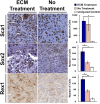Epimorphic regeneration approach to tissue replacement in adult mammals
- PMID: 19966310
- PMCID: PMC2840465
- DOI: 10.1073/pnas.0905851106
Epimorphic regeneration approach to tissue replacement in adult mammals
Abstract
Urodeles and fetal mammals are capable of impressive epimorphic regeneration in a variety of tissues, whereas the typical default response to injury in adult mammals consists of inflammation and scar tissue formation. One component of epimorphic regeneration is the recruitment of resident progenitor and stem cells to a site of injury. Bioactive molecules resulting from degradation of extracellular matrix (ECM) have been shown to recruit a variety of progenitor and stem cells in vitro in adult mammals. The ability to recruit multipotential cells to the site of injury by in vivo administration of chemotactic ECM degradation products in a mammalian model of digit amputation was investigated in the present study. Adult, 6- to 8-week-old C57/BL6 mice were subjected to midsecond phalanx amputation of the third digit of the right hind foot and either treated with chemotactic ECM degradation products or left untreated. At 14 days after amputation, mice treated with ECM degradation products showed an accumulation of heterogeneous cells that expressed markers of multipotency, including Sox2, Sca1, and Rex1 (Zfp42). Cells isolated from the site of amputation were capable of differentiation along neuroectodermal and mesodermal lineages, whereas cells isolated from control mice were capable of differentiation along only mesodermal lineages. The present findings demonstrate the recruitment of endogenous stem cells to a site of injury, and/or their generation/proliferation therein, in response to ECM degradation products.
Conflict of interest statement
The authors declare no conflict of interest.
Figures



References
-
- Chan RJ, Yoder MC. The multiple facets of hematopoietic stem cells. Curr Neurovasc Res. 2004;1:197–206. - PubMed
-
- Epstein WL, Maibach HI. Cell renewal in human epidermis. Arch Dermatol. 1965;92:462–468. - PubMed
-
- Lee LP, Lau PY, Chan CW. A simple and efficient treatment for fingertip injuries. J Hand Surg [Br] 1995;20:63–71. - PubMed
MeSH terms
Substances
Grants and funding
LinkOut - more resources
Full Text Sources
Other Literature Sources

